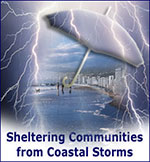Ecological Assessment of Storm Impacts
 Welcome to the website of the Ecological Assessment of Storm Impacts on Marine Resources. This project is a part of the Coastal Storms Program (CSP) and is designed to assess potential effects on fish and shellfish from non-point source pollution.
Welcome to the website of the Ecological Assessment of Storm Impacts on Marine Resources. This project is a part of the Coastal Storms Program (CSP) and is designed to assess potential effects on fish and shellfish from non-point source pollution.
For more about this project, please view the project description.
Resources available on this website
This site includes a database of chemical and toxicological information on contaminants permitted for use in the St. Johns River Watershed, Florida, and the lower Columbia River watershed in Oregon and Washington. It will include other classes of chemical contaminants and other study areas in the future. You can search the database by:
- Chemical Abstract Service registry number
- Name of Contaminant
- Molecular Formula
The database provides estimates of potential chemical runoff based upon available landuse, and either application or loading information. Reported agricultural applications were used when available. USEPA-permitted chemical application information or loading rates derived from scientific literature were used wherever actual applications were not reported. Locations were cross-referenced to available GIS data layers.
Queries will also provide available information on chemical structure, molecular weight, octanol-water partition coefficients, organic carbon partition coefficients, water solubility, persistence in soil, general toxicity information and specific toxicity levels, to five groups of organisms (algae, mollusks, finfish, crustaceans, and select terrestrial animals).
Toxicity to terrestrial animals is provided as a general comparison to a large body of available toxicological literature. All of this information was obtained from available scientific literature and is provided to assist identifying locations where risks to aquatic organisms might occur following storm events.
To begin querying the project's database, visit the basic search page, or examine data from the detailed search. To learn more about this project, please look at the Project Overview.